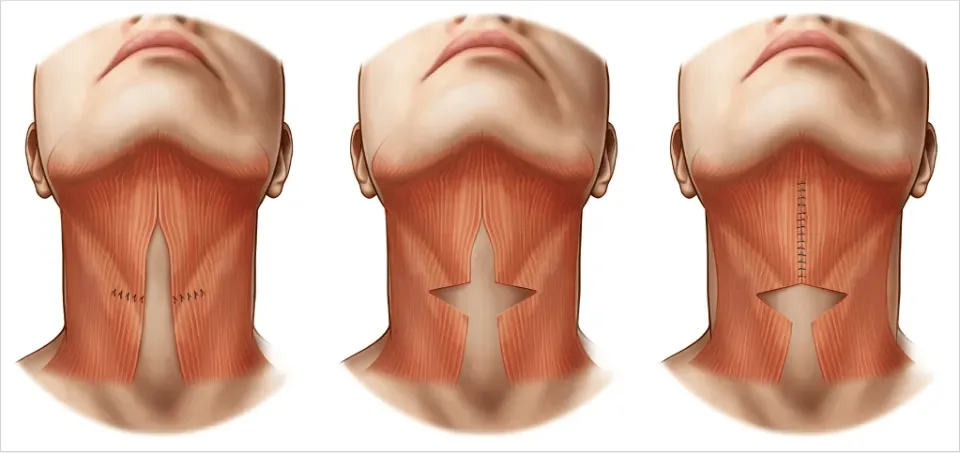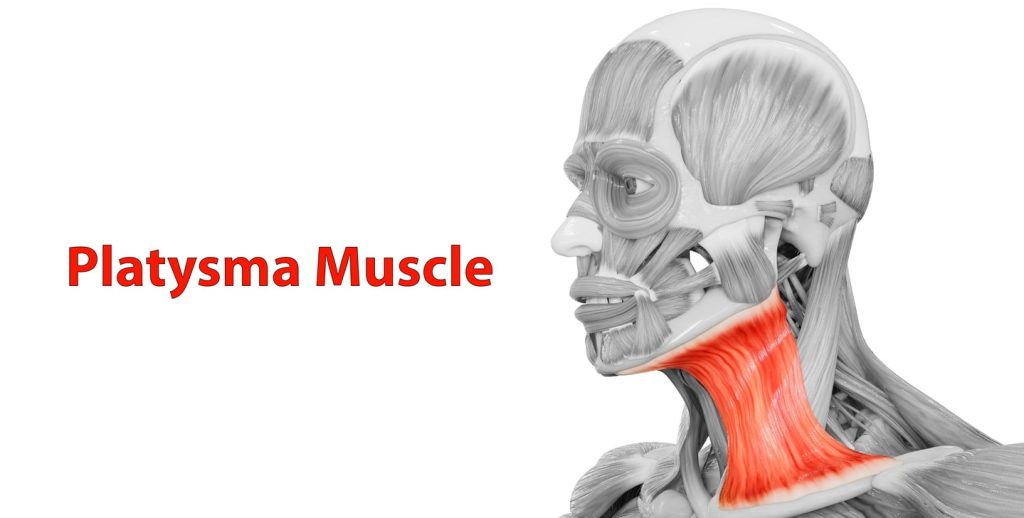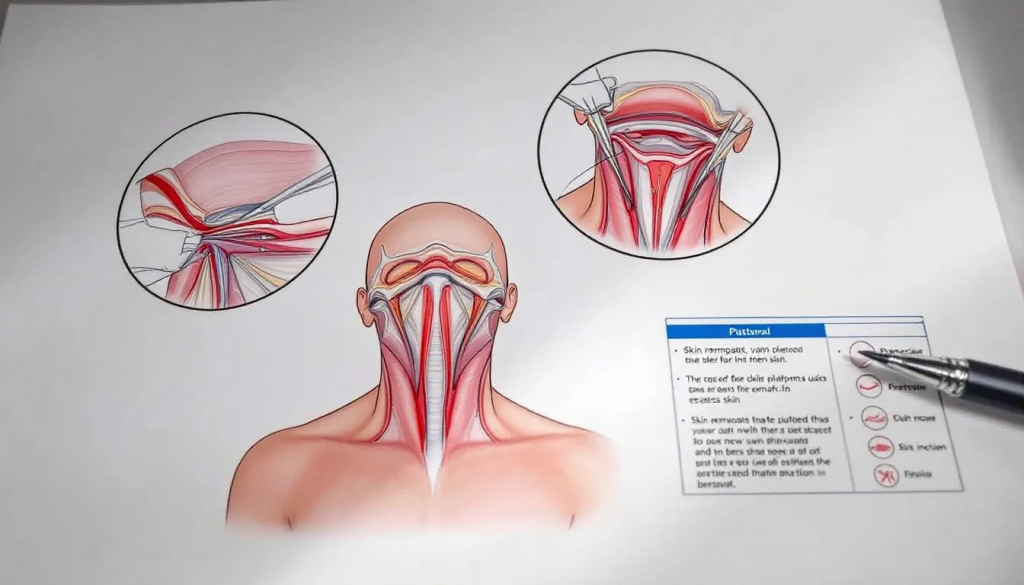Platysmaplasty (Neck lift) in Newcastle, Maitland & Hunter Valley Australia
Book Online NowPlatysmaplasty (neck lift), tightens the muscles and removes excess skin in the neck area.
Key Takeaways
- Platysmaplasty (neck lift) is a surgical procedure designed to improve the appearance of the neck by tightening the platysma muscle and removing excess skin.
- The procedure involves various surgical techniques, including skin removal, neck suction-assisted lipectomy, and muscle tightening, with the Corset Platysmaplasty technique specifically targeting platysmal bands.
- Recovery from platysmaplasty requires careful management and adherence to post-surgery guidelines to minimise risks and optimise results, highlighting the importance of patient preparation and aftercare.
Platysmaplasty: Understanding the Procedure for Treating Neck Bands
Platysmaplasty is a surgical procedure designed to treat neck bands, also known as platysmal bands, which are visible vertical cords that appear along the front of the neck. These bands, which can extend from the chin down to the collarbone, are a common concern for individuals as they age, becoming more prominent over time due to changes in the platysma muscle and a decline in skin elasticity.
Book Online NowWhat Are Neck Bands?
Neck bands are typically categorised into two types based on their appearance and the underlying cause:
- Static Bands: Structural changes between the skin and the underlying platysma muscle, skin laxity, a reduction in subcutaneous fat, and the aging process cause static bands to be visible even when the neck is at rest.
- Dynamic Bands: These bands are less visible when the neck is relaxed but become prominent when the platysma muscle contracts, such as during facial expressions like smiling or grimacing. Dynamic bands are often observed in individuals who frequently use their neck muscles, resulting in hyperactivity of the platysma muscle.
Platysmaplasty Procedure

Platysmaplasty is typically performed to change the appearance of neck bands, particularly when they become more pronounced with age. The procedure involves removing or tightening the platysma muscle to smooth the neck area and reduce the appearance of bands.
The surgery is generally performed using one of two approaches:
- Incision Under the Chin: In this method, Dr. Beldholm makes a small incision under the chin. Through this incision, he can access the platysma muscle and remove or reposition it to eliminate the visible bands. This approach offers a less invasive solution with a smaller scar.
- Direct Excision of Skin in the Neck Area: In more extensive cases, Dr. Beldholm may perform a direct excision of skin in the neck area. More commonly performed on post-weight-loss patients, this method involves a more significant surgical intervention, which removes excess skin and tightens the platysma muscle.
Combination with Rhytidectomy (Facelift)
Platysmaplasty is often performed in combination with a rhytidectomy (facelift). This procedure tightens and lifts the skin on the lower face, and when combined with platysmaplasty, provides a comprehensive treatment of the neck and lower face. This combination approach not only smooths the neck by tightening the platysmal bands but also smooths the overall appearance of the jawline and the skin around the lower face.
Facial Surgeries Offered by Dr. Beldholm

Understanding the anatomy of the platysma muscle is crucial to grasping why platysmaplasty is effective. The platysma muscle is a broad sheet of muscle fibres extending from the upper chest to the lower face, responsible for movement in this region. In individuals with prominent musculature, this muscle is often very noticeable, contributing to a well-defined neck and jawline.
As we age, the platysma muscle weakens, leading to its separation and the formation of vertical bands known as platysmal bands. These bands, combined with other age-related changes, such as excess fat and skin under the chin, significantly impact the aesthetic appearance of the neck muscles.
Factors such as gravity and genetic inheritance contribute to the loss of definition in the neck and jawline. Recognising these changes helps explain why platysmaplasty targets the platysma muscle to modify the appearance of your neck.
Book Online Now
Who Should Consider Platysmaplasty?
Platysmaplasty is an effective surgical procedure designed to tighten the neck bands (platysmal bands), which can become more prominent with age. While anyone dealing with these neck bands may consider the procedure, there are specific individuals who are better suited for platysmaplasty.
Here’s a breakdown of who might benefit most from this procedure:
Book Online NowIndividuals with Visible Neck Bands
Platysmaplasty is ideal for individuals with noticeable vertical neck bands, particularly those that persist even when the neck is at rest (static bands). These bands can be a result of ageing, loss of skin elasticity, or changes in the platysma muscle.
Ageing Adults
As people age, the platysma muscle can weaken, and the skin loses its elasticity. This process causes neck bands to become more prominent. Adults in their 40s, 50s, or older who are noticing the appearance of these bands may find platysmaplasty to be an option.
People with Excess Skin or Muscle Laxity in the Neck Area
Individuals who have experienced significant skin laxity in the neck area, often due to ageing or weight loss, may benefit from platysmaplasty.
Platysmaplasty is frequently performed in combination with a facelift (Rhytidectomy). This can provide more comprehensive results for individuals considering a Rhytidectomy to remove or tighten skin on the face and platysmaplasty to augment the neck..
Comparing Neck Lift (Meloplasty) and Facelift (Rhytidectomy) Procedures
Understanding the differences between a Meloplasty (Neck lift) Rhytidectomy (Facelift) is crucial when considering either of these procedures. A platysmaplasty focuses specifically on concerns below the chin, such as submental fat and neck bands. On the other hand, a Rhytidectomy targets the lower two-thirds of the face, including the cheeks and jawline. Additionally, Rhytidectomy surgery can complement the results of a neck lift (Meloplasty) procedure.
The main difference lies in the areas each procedure targets. The surgical technique for Rhytidectomy is generally more intricate due to the complexity of facial anatomy, which also means a longer recovery time compared to neck lifts (Meloplasty).
Combining a Rhytidectomy and Meloplasty into one surgery is common for those seeking comprehensive results. This combination can provide more harmonious and long-lasting results, shorten recovery time, and allow patients to be out of commission only once.

Surgical Techniques in Platysmaplasty
Platysmaplasty involves various surgical techniques that often include skin removal, suction-assisted lipectomy of the neck, and muscle tightening, each targeting specific aspects of the neck’s appearance. The procedure typically involves making incisions under the chin and around the ears to access and reposition the neck tissue effectively.
One innovative technique is the Corset Platysmaplasty, which sutures the separated platysma muscle bands together. This section will delve deeper into these techniques, offering insights into how specialist surgeons achieve results.
Skin Removal
Skin removal is a crucial component of platysmaplasty, which involves excising the loose skin that often accompanies aging. Surgeons make strategic incisions under the chin, around the ears, or along the hairline to remove excess skin. The quantity of skin excised is tailored to match individual anatomical variations.
Suction-Assisted Lipectomy (liposuction) of the Neck
Suction-assisted lipectomy of the neck is often performed in conjunction with platysmaplasty to change the neck by removing excess fat. While it does not target skin laxity, it effectively reduces fat deposits that contribute to a double chin (Submental fat) and less definition. Typically, Suction-Assisted Lipectomy of the Neck is conducted through three small incisions.
This technique is particularly beneficial for individuals with fat deposits in the neck region. Removing this excess fat changes the overall aesthetic of the neck, complementing the platysmaplasty results.

Preparing for Platysmaplasty Surgery
Preparation is key to ensuring a successful platysmaplasty surgery and smooth recovery. A detailed medical history review is essential for identifying any prior surgeries or lifestyle habits that may affect the surgical outcome. This process includes a clinical examination, preoperative photography, blood workup, and an anaesthetic assessment.
Patients should discontinue medications such as aspirin, non-steroidal anti-inflammatory drugs, and certain herbal supplements before surgery to reduce the risk of complications. Maintaining a balanced lifestyle, such as following a wholesome diet, avoiding tobacco products, and staying well-hydrated, can significantly facilitate healing and recovery.
Initial consultations with the surgeon are crucial for setting realistic expectations and outlining the surgical process.
What to Expect During Recovery
Recovery from platysmaplasty typically involves managing swelling and adhering to specific care instructions to ensure optimal healing. For the most part, recovery occurs on an outpatient basis, allowing patients to return home the same day. Post-surgery, patients can expect swelling and bruising in the neck area, along with muscle tightness that may persist for several months.
Following aftercare instructions, such as avoiding alcohol, keeping your head elevated during sleep, and refraining from lifting heavy objects, is crucial for a smooth recovery. Surgeons may place temporary tubes to help drain fluids from beneath the skin; patients should be vigilant for signs of complications, such as unusual bleeding or infection.
Wearing loose, comfortable clothing and striking a balance between rest and light activities can also aid in the recovery process.
Post-Surgery Care to Maximise Results of Your Platysmaplasty Surgery
Adhering to the specific post-surgery guidelines provided by Dr. Beldholm is crucial for minimising complications and ensuring a successful recovery. Post-surgery care is essential for achieving optimal results from platysmaplasty. Following these guidelines can help mitigate risks, such as scarring and infection. Carefully following Dr. Beldholm’s post-surgery care instructions has a significant impact on the recovery experience and helps achieve the best possible results from platysmaplasty.
